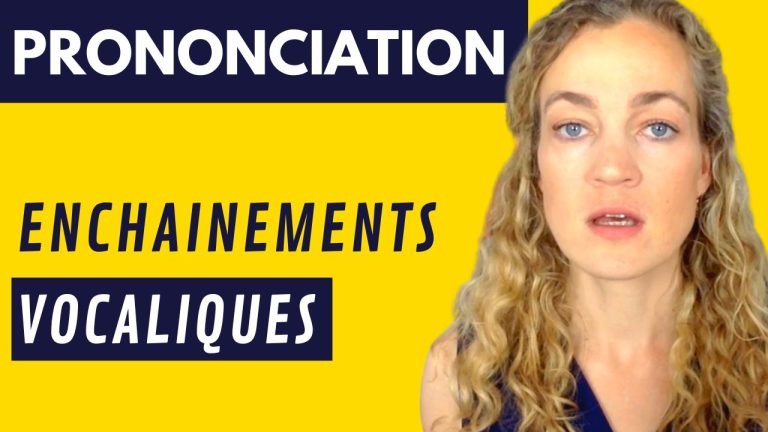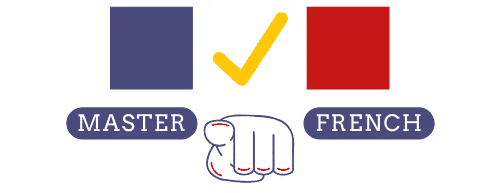Vowel sequencing in French pronunciation
Updated: 24 June, 2023 by Mylene in Pronunciation Lessons ▪

In this lesson, we are going to study the pronunciation of vowel sequences. In French, when a word ends with a vowel and the next word also begins with a vowel, no pause exists between the two words. This means that you’ll have to link the vowels together. This is referred to as enchainement vocalique in French. It is also called a hiatus. In fact, vowel linking makes it possible to maintain fluency in pronunciation and facilitate comprehension during oral communication in French. Therefore, even without a liaison, the liaison can be implicitly implied thanks to the sound continuity between the words. This distinct pronunciation of chained consonants contributes to the musicality and clarity of the French language when spoken.
In this article, we explore this French pronunciation topic by providing examples and examining different scenarios where two consecutive vowels are found in separate syllables, either within a word or at the junction of two words.
Examples to illustrate vowel sequencing in French
Identify the common point between these two sentences:
- il va appeler
- j’en veux un
In both cases, you have to link the vowel sounds.
- il va appeler : the two a vowels are linked. Il va appeler : the word “va” ends with the phonetic vowel /a/ and the word “appeler” also starts with the phonetic vowel /a/. In this case, I can link the two vowels.
- j’en veux un : the phonetic vowel /ø/ and the nasal vowel /ɛ̃/ are linked. The word “veux” ends with the oral vowel /ø/ and the word “un” is the nasal vowel /ɛ̃/. In this case, the two vowels are also linked.
Notice that the word veux ends in the consonant written X, but this consonant is a silent letter. Therefore, the word veux ends in a pronounced vowel; veux is pronounced /vø/.
Explaining vowel linking in French
Here’s a video that shows how to link vowel sounds and explains to you how to do it. I would suggest that you exercise to chain vowels in French. But be careful, it’s true that vowels get connected, but you need to hear two vowels each time. For instance, it’s important to tell the difference between j’étais et j’ai été.
- j’étais is pronounced /ʒetɛ/. The sound /e/ is pronounced once.
- j’ai été is pronounced /ʒeete/. The sound /e/ is pronounced twice.
In addition to linking vowels, a sequence of consonant sounds can occur between the final consonant of one word and the initial vowel sound of the following word. This phenomenon is known as enchainement consonantique in French. If you’re interested in learning more about this topic, check out this video about consonant enchainement.
Linking vowels within the same word
We can connect vowels within the same word. For example, in the word vidéo, the sound é and the sound o are linked.
In the word agréable, there’s a connection between the vowel é and the vowel a: agréable. Note that we hear three syllables: a gré able. The second syllable ends with the vowel é (gré) and the third syllable begins with the vowel a (able). This is why we are going to perform a vowel sequence in the word agréable.
Additional examples:
- aéroport : the vowels a et é are linked.
- recréer : there are three syllables re cré er, A vowel linking is made between “cré” and “er”.
- anti-aérien : here we link the three vowels i a é.
Vowel linking and the h consonant
When the consonant h is between two vowels in a word, you must pronounce the vowel before and the vowel after.
This is the case of the word ébahi. The same goes for the words ébahi, cahier et brouhaha. Please note that brouhaha contains three syllables.
Vowel linking between distinct words
Now, let us move on to the vowel sequences between several words. Let’s look at some examples:
- j’ai⁀attendu : ai et a are linked.
- attend⁀un peu : the nasal vowel en and the nasal vowel un are connected. The consonant “d” is a silent letter in the word attend.
- tu⁀as⁀oublié : the three vowels u, a, and ou are linked.
- j’ai ⁀eu⁀une idée : the sound ai and eu (two vowel connections in this case).
- il a⁀eu⁀un an⁀en mars : this sentence contains numerous vowel connections.
- il faut⁀en prendre un⁀en⁀haut : exercise to pronounce the vowel connections in en haut.
A vowel sequencing test: how to pronounce?
Pronounce the vowel sequence between each pair of words to hear the difference.
- il a une lettre / il a eu une lettre,
- j’ai été étonné / j’étais étonné,
- j’étais aimable / j’ai été aimable.
Dive deeper
In spoken French, words often tend to link together, creating a continuity where the graphic separation between them is not obvious. This particularity is evident in both the liaisons and the various types of sequences. This continuity plays a significant role in the fluency and harmony of the spoken language. Understanding when to perform a vowel sequence and when to perform a liaison is important. For more information on bindings, you can consult these two articles on mandatory liaisons and forbidden liaisons in French.

